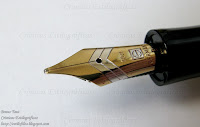I have already spoken about
jumbo pens on these Chronicles. Big as they are, their purpose was different from those luxurious pens like the
Pilot hoshiawase with a size-8 nib recently described. Their main argument, we are told, was to ease the grip of those with arthritis or similar affections in their hands. And, in fact, few of these oversized pens implemented gold nibs.
The pen, uncapped. The shut-off valve is half open, as can be seen on the tail of the pen.
I wonder, though, if at that time –1930s and 1940s— there were real demographic arguments in Japan to justify this type of pen. That would be true in nowadays Japan, a country where
more than 20% of the population is over the age of 65 years, and increasing--, but these are not the days of fountain pens but of cell-phones and touch-screens, although these senior citizens might not feel at ease dealing with digital technology.
The clip is the only place where there is a brand engraving. However, it only means that the clip had been produced by the company Fukunaka Seisakusho.
Anyway, jumbo pens are out there and deserve some attention from all of us fond of Japanese pens. If only, because of its historical relevance.
The exposed part of the nib is 25 mm long. The feed is made of ebonite.
Fukunaka Seisakusho produced pens between 1913 and the 1940s under a number of names —Horse Face, Ford, Arabian— as well as parts for other manufacturers who labeled their pens with their own brands. The Fukunaka’s clips were branded, as well, with a number of names: Everclip, New Clip, Perfect. And New Clip is the only band stamped on this pen, on its clip. The nib is engraved with a generic description: “Special / Iridium / Pen”. None of that provides real information on the actual manufacturer of this pen. As about the production date, the more elaborated feed might indicate a later product from the 1940s or even later, using remaining parts from Fukunaka Seisakusho.
The pen section, from the back. The conic shape is the seat for the shut-off valve.
The pen, in summary, is a eyedropper with shut-off valve. The ink
deposit is in accordance with the size of the pen—over 8 ml. The nib is a
generic steel unit, gold plated, cut as a medium stub in what most
likely was an after market modification. It is nicely wet and pleasant
to use. But it is also a slow starter due, probably, to the absence of
inner cap and to
the interruption of the connection with the ink deposit –by closing the shut-off valve— when the pen is not in use.
A thick pen is, undoubtedly, easier to grip than a thin one. Now, is
this a friendly and comfortable pen to use? It is heavy, over 50 g, and
its center of mass is a bit high up at around 80 mm from the nib tip,
unposted. This later fact is not very different from many other pens
(especially if posted), but few are as heavy as this one.
This is not a pen to carry around. It does not fit in any pocket and few
pen cases could accommodate it. So, better reserve it for domestic use.
These are its dimensions:
Length closed: 160 mm.
Length open: 140 mm.
Length posted: 201 mm (but who might want to post this pen?).
Diameter: 26 mm.
Weight (dry): 55.9 g.
Ink deposit: about 8.5 ml.
Center of mass, unposted: at 78 mm. to the nib end, dry;
at 80 mm. to the nib end, full.
Platinum pocket pen, stainless steel with black stripes – Platinum black
Bruno Taut
September 19th, 2012
labels: Japón, marca desconocida, New Clip, Fukunaka Seisakusho.
















































